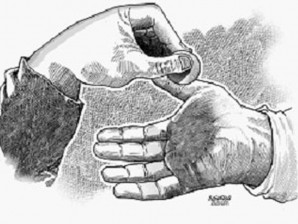I entered a coffee shop and, taking my cue from a famous author, ordered a café au lait. I too had brought a notebook and a pen. A young man took my order and received the payment. But, after fumbling around, he declared that he could not as yet give the exact change—he lacked one coin. This he promised to give as soon as the customers came and replenished the till.
I found myself a table that had a view of the outside. Two young ladies passed by the coffee shop, twice, perhaps to survey its virtues, and then, gingerly, noiselessly, entered. The young man gave them a table near the wall across from mine. As I watched them I remembered the coin.
Collectors know what I mean. Coins represent more than just their monetary value. This, in fact, can surpass that which the banks have assigned to them. For instance, they can become so rare as to fetch a fortune.
Obviously, the young man had forgotten the change. It was just a petty amount, but the more I thought of it the more the coin acquired a symbolic character. Indeed, at that moment, it stood for no less than justice.
I tried to distract myself. I brainstormed the other things that a coin can represent. It often carries the image of the head of state, and so stands for the country. Or bears the profile of a hero, signifying the ideals that the hero fought for—independence, freedom.
To St. Irenaeus, a coin—two coins, to be exact—would denote the Holy Spirit.
In the Gospel of John, Jesus told his disciples, “If you love me, you will obey what I command. And I will ask the Father, and he will give you another Counselor to be with you forever—the Spirit of truth.”
For counselor, the Gospel uses the Greek word Parakletos or Paraclete. This means “advocate,” “intercessor,” “teacher,” “helper,” “comforter.”
Jesus likewise told the disciples, “I am in my Father, and you are in me, and I am in you.” He added, “If anyone loves me, he will obey my teaching. My Father will love him and we will come to him and make our home with him.”
I’m sure that Jesus meant this in a real, not a figurative, sense. But I could not imagine this happening for as long as Christ was with the disciples in the flesh. And so he had to leave—in order to stay. Through the Holy Spirit.
In his work, “Against Heresies,” St. Irenaeus tries to explain this by using the Parable of the Good Samaritan as analogy. “And so the Lord in his pity for man, who had fallen into the hands of brigands, having himself bound up his wounds and left for his care two coins bearing the royal image, entrusted him to the Holy Spirit. Now, through the Spirit, the image and inscription of the Father and the Son have been given to us, and it is our duty to use the coin committed to our charge and make it yield a rich profit for the Lord.”
Despite its looseness, the analogy holds. Sin stripped man of his dignity, beat him up and left him half-dead on the road. Jesus came and, himself taking on man’s debasement and affliction, treated and bound up man’s wounds. Before going away, Jesus entrusted man to the care of the Holy Spirit to await his return. He left behind two coins—one in the image of the Father and the other in the image of the Son. This currency is the currency of grace, of life in the Holy Spirit, of the love that will nourish and strengthen and protect the believers until the return of Christ at the end of time.
Laughter from the other side. The once-composed young ladies had become boisterous, shattered my musing. The young man continued to show no signs of keeping his promise. And in myself I found no signs of forgetting it. And so, before I left, I asked him for the coin. Which he readily handed to me without a word. And which I graciously accepted with a smile.


